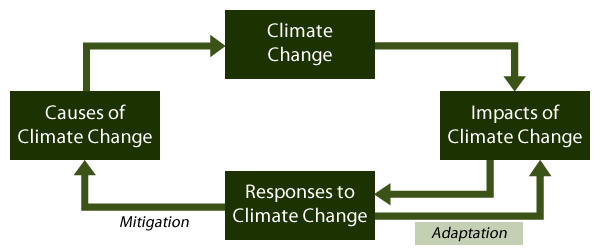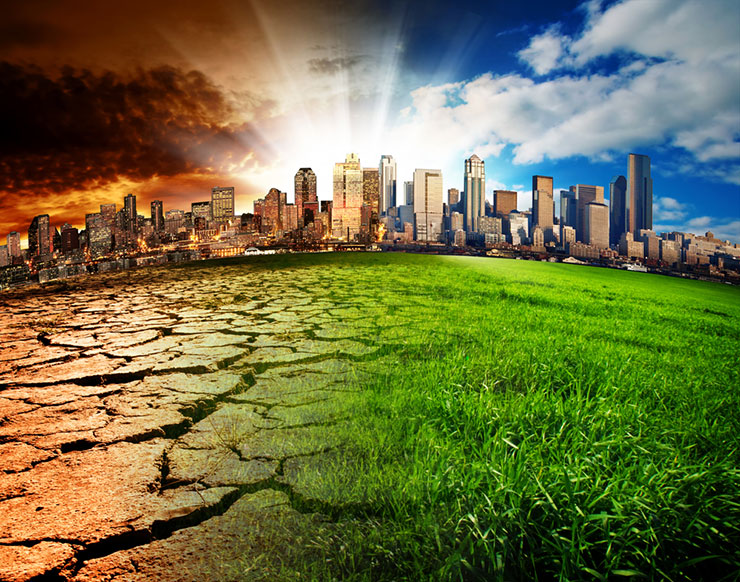Adaptation to global warming
Adaptation (Latin adaptare = adjust ) and adaptation to global warming (climate change ) has the goal to come to terms with already made climate change and adapt to expected changes so that future damage can be avoided as far as possible, or even opportunities of climate change, where they arise, are used. "Adaptation can thus be either reactive or proactive done ( precautionary ) and affects both social and natural systems. " The IPCC defines adaptation as " initiatives and measures to reduce the sensitivity of natural and human systems against actual or expected climate change effects on decrease. " the ability to adapt is referred as adaptability ( " adaptive capacity " ). It varies depending on various parameters, such as the level of development or the economic performance of a country or a society of knowledge on the expected impact of climate change, etc. For the adaptation to climate change often, the shortened term is used climate adaptation.
Adaptation measures
The IPCC scientists point out that the range of potential adaptation measures is very extensive; it ranges from purely technological (eg coastal defenses ) about changes in behavior (eg, eating habits, choice of holiday destinations ) and economic decisions (such as changes in land management ) to political decisions (eg, planning regulations, emission reduction targets ). They can be taken by private or public actors, and implemented autonomous or planned. The proper implementation of adaptation measures requires appropriate knowledge, however, it conflicted with still enormous ecological, economic, informational, social, awareness and behavioral barriers to implementation of adaptation measures. Given the fact that climate change has an impact on many sectors of an economy, the integration of adaptation into national development plans, for example, poverty reduction strategies and sectoral planning processes is a key challenge.
Germany has a German Adaptation Strategy (DAS) decided, for example, in December 2008, which is being developed into an action plan. In Austria, the national adaptation strategy has been developed to climate change since September 2007 on behalf of the Federal Ministry of Agriculture and approved by the Council of Ministers on 23 October 2012. On April 16, 2013 EU strategy was presented to adapt to climate change by the EU Commission. Up to this date 15 EU Member States had developed its own adaptation strategy. Countries like Bangladesh and Kenya have integrated national climate strategies decided to combine both customization, as well as the avoidance of emissions.
Adaptability
The IPCC understands adaptability ( "adaptive capacity" ), the " whole of capabilities, resources and institutions of a country or region to implement effective adaptation measures. " It depends on diverse factors such as the wealth of available technology, the quality of education, infrastructure, management skills or access to knowledge.
Adaptation and Vulnerability
Overall, the ability to adapt is strongly influenced by the vulnerability. Considering the vulnerability of countries or companies, the socio -economic vulnerability plays a central role. In particular, the following three factors determine the extent of vulnerability:
- The exposure ( how much the climate changes in a country or area )
- The sensitivity ( the consequences of the change has ), and finally
- Adaptability ( the ability to adapt to changes and to protect against negative consequences ).
The IPCC is one of the countries and regions that are characterized by a particularly high vulnerability, in particular the least developed developing countries, the so-called Least Developed Countries ( LDCs). Unlike most developed countries, which lie in temperate climatic zones, most developing countries are heavily exposed due to their geographical location. In the tropics and subtropics extreme weather events such as cyclones and droughts occur more frequently and fall out more. Many developing countries are also particularly sensitive because the weather-dependent agriculture shapes their economies. To make matters worse, that a large part of the population lives on subsistence farming. Also the adaptation capacities in developing countries, it is typically a bad way. For one, there is not enough money for targeted measures, on the other hand there is often a lack of competent personnel and effective institutions. To support the LDCs in climate policy of the United Nations special funding agreement ( see 5 ) in the frame.
Regional vulnerability
The vulnerability is particularly high according to the IPCC in the following regions:
- Across Africa expected because of the strong climate impacts and low adaptive capacity,
- In small island states, which threatens sea level rise in their existence, and
- In the large delta areas and coastal regions in Asia and Africa with high population densities, the floods and storms are regularly exposed,
- In the Arctic, due to the effects due to the particularly high heating rate.
This does not mean that can not get potentially massive changes on the industrial countries, but this tends to be more as the temperature increases, the previously brings significant negative impact in the developing countries themselves.
Adaptation in the UN climate policy
A central policy framework for international climate debate is the adopted in 1992 Framework Convention on Climate Change (UNFCCC ), which has now been ratified by 192 States. There is already referred to the issue of adaptation, although at that time still more focus on the prevention of dangerous climate change was (Article 2 of the UNFCCC). At the latest with the 3rd Assessment Report of the IPCC, published in 2001, the need for adaptation and understanding has increased significantly for it. The UNFCCC takes in Articles 2 and 4 ( 4.1 (b, e, f), 4.8 and 4.9) with respect to adaptation. In the Kyoto Protocol, which was agreed in 1997 and 2005 came into force, adaptation takes Although only a small role, but the decision to establish a special UN Adaptation Fund ( " Adaptation Fund ") was there a rule be taken to the most affected developing countries to assist in the financing of adaptation. The Bali Action Plan ( Bali Roadmap ) adopted in Bali in 2007, for the first time treated adjustment with an equal weight as the avoidance of emissions, and served as a framework for subsequent negotiations on a new comprehensive international climate agreement.
In particular, from the perspective of scientific support for governments was enacted in 2006, the Nairobi work program on impacts, adaptation and vulnerability is an important step. Already at the UN climate summit 2001 in Marrakech guidelines for LDCs for the development of national action programs for adaptation ( NAPAs ) were adopted, explaining the initial situation of the country, the consequences and the regional impacts of climate change on the country whose vulnerability and possible adaptation strategies as well as the short term necessities projects should identify. By May 2009, the Secretariat of the UNFCCC were present 40 developed countries NAPAs.










